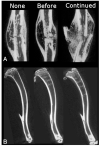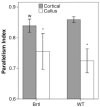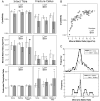Fracture healing with alendronate treatment in the Brtl/+ mouse model of osteogenesis imperfecta
- PMID: 23774443
- PMCID: PMC3999166
- DOI: 10.1016/j.bone.2013.06.003
Fracture healing with alendronate treatment in the Brtl/+ mouse model of osteogenesis imperfecta
Abstract
Osteogenesis imperfecta (OI) is a heritable bone dysplasia characterized by increased skeletal fragility. Patients are often treated with bisphosphonates to attempt to reduce fracture risk. However, bisphosphonates reside in the skeleton for many years and long-term administration may impact bone material quality. Acutely, there is concern about risk of non-union of fractures that occur near the time of bisphosphonate administration. This study investigated the effect of alendronate, a potent aminobisphosphonate, on fracture healing. Using the Brtl/+ murine model of type IV OI, tibial fractures were generated in 8-week-old mice that were untreated, treated with alendronate before fracture, or treated before and after fracture. After 2, 3, or 5 weeks of healing, tibiae were assessed using microcomputed tomography (μCT), torsion testing, quantitative histomorphometry, and Raman microspectroscopy. There were no morphologic, biomechanical or histomorphometric differences in callus between untreated mice and mice that received alendronate before fracture. Alendronate treatment before fracture did not cause a significant increase in cartilage retention in fracture callus. Both Brtl/+ and WT mice that received alendronate before and after fracture had increases in the callus volume, bone volume fraction and torque at failure after 5 weeks of healing. Raman microspectroscopy results did not show any effects of alendronate in wild-type mice, but calluses from Brtl/+ mice treated with alendronate during healing had a decreased mineral-to-matrix ratio, decreased crystallinity and an increased carbonate-to-phosphate ratio. Treatment with alendronate altered the dynamics of healing by preventing callus volume decreases later in the healing process. Fracture healing in Brtl/+ untreated animals was not significantly different from animals in which alendronate was halted at the time of fracture.
Keywords: Bisphosphonates; Bone; Fracture repair; Osteogenesis imperfecta; Rodent.
Copyright © 2013 Elsevier Inc. All rights reserved.
Figures







Similar articles
-
Alendronate treatment of the brtl osteogenesis imperfecta mouse improves femoral geometry and load response before fracture but decreases predicted material properties and has detrimental effects on osteoblasts and bone formation.J Bone Miner Res. 2009 May;24(5):849-59. doi: 10.1359/jbmr.081238. J Bone Miner Res. 2009. PMID: 19113917 Free PMC article.
-
Modeling anabolic and antiresorptive therapies for fracture healing in a mouse model of osteogenesis imperfecta.J Orthop Res. 2023 Apr;41(4):808-814. doi: 10.1002/jor.25414. Epub 2022 Jul 21. J Orthop Res. 2023. PMID: 35803595
-
Adult Brtl/+ mouse model of osteogenesis imperfecta demonstrates anabolic response to sclerostin antibody treatment with increased bone mass and strength.Osteoporos Int. 2014 Aug;25(8):2097-107. doi: 10.1007/s00198-014-2737-y. Epub 2014 May 7. Osteoporos Int. 2014. PMID: 24803333 Free PMC article.
-
Finite element analysis of bone strength in osteogenesis imperfecta.Bone. 2020 Apr;133:115250. doi: 10.1016/j.bone.2020.115250. Epub 2020 Jan 22. Bone. 2020. PMID: 31981754 Free PMC article. Review.
-
Pharmacological agents for bone fracture healing: talking points from recent clinical trials.Expert Opin Investig Drugs. 2023 Jul-Dec;32(9):855-865. doi: 10.1080/13543784.2023.2263352. Epub 2023 Oct 13. Expert Opin Investig Drugs. 2023. PMID: 37740660 Review.
Cited by
-
Compositional assessment of bone by Raman spectroscopy.Analyst. 2021 Dec 6;146(24):7464-7490. doi: 10.1039/d1an01560e. Analyst. 2021. PMID: 34786574 Free PMC article. Review.
-
Animal models of osteogenesis imperfecta: applications in clinical research.Orthop Res Rev. 2016 Sep 27;8:41-55. doi: 10.2147/ORR.S85198. eCollection 2016. Orthop Res Rev. 2016. PMID: 30774469 Free PMC article. Review.
-
Comparison between different methods for biomechanical assessment of ex vivo fracture callus stiffness in small animal bone healing studies.PLoS One. 2015 Mar 17;10(3):e0119603. doi: 10.1371/journal.pone.0119603. eCollection 2015. PLoS One. 2015. PMID: 25781027 Free PMC article.
-
Correlations Between Bone Mechanical Properties and Bone Composition Parameters in Mouse Models of Dominant and Recessive Osteogenesis Imperfecta and the Response to Anti-TGF-β Treatment.J Bone Miner Res. 2017 Feb;32(2):347-359. doi: 10.1002/jbmr.2997. Epub 2016 Oct 20. J Bone Miner Res. 2017. PMID: 27649409 Free PMC article.
-
Methodology, selection, and integration of fracture healing assessments in mice.J Orthop Res. 2021 Nov;39(11):2295-2309. doi: 10.1002/jor.25172. Epub 2021 Sep 10. J Orthop Res. 2021. PMID: 34436797 Free PMC article. Review.
References
-
- Marini JC, Forlino A, Cabral WA, Barnes AM, San Antonio JD, Milgrom S, et al. Consortium for osteogenesis imperfecta mutations in the helical domain of type I collagen: regions rich in lethal mutations align with collagen binding sites for integrins and proteoglycans. Hum Mutat. 2007;28(3):209–21. - PMC - PubMed
-
- Marini JC, Cabral WA, Barnes AM, Chang W. Components of the collagen prolyl 3-hydroxylation complex are crucial for normal bone development. Cell Cycle. 2007;6(14):1675–81. - PubMed
-
- Herring JA, Tachdjian MO, editors. Tachdjian’s Pediatric Orthopaedics. 3rd ed Vol. 3. W.B. Saunders; Philadelphia: 2002.
-
- Cheung MS, Glorieux FH, Rauch F. Natural history of hyperplastic callus formation in osteogenesis imperfecta type V. J Bone Miner Res. 2007;22(8):1181–6. - PubMed
Publication types
MeSH terms
Substances
Grants and funding
LinkOut - more resources
Full Text Sources
Other Literature Sources
Medical
Molecular Biology Databases

